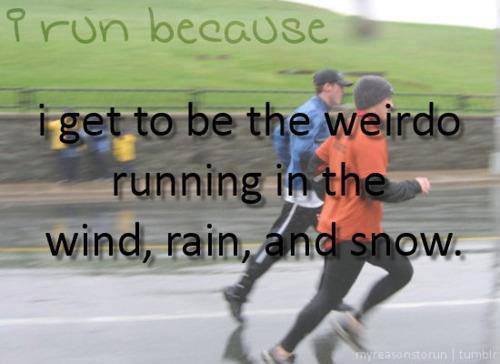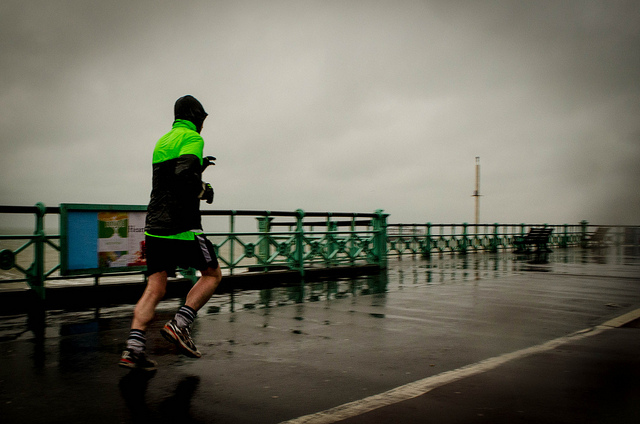After a wonderfully sunny October in Vancouver, the rainy season has finally arrived! For the next several months, I’ll be doing a lot of running in the rain. Here are some of the tips I’ve learned to help me make the most of it.
Tips for Running in the Rain
- First and foremost, accept the fact that you are going to get wet. Even so-called waterproof fabrics have a limit, and they often aren’t too breathable, leading to overheating and excess perspiration, which will condense on the inside. This defeats the purpose of wearing waterproof clothes in the first place.
- Dress in layers of lightweight moisture wicking (not cotton!) fabrics. But be sure to dress for the temperature, and not the weather. Over-dressing because of rain, will just lead you to perspire more, again defeating the goal.
If it is windy, consider a windproof shell as your outer layer. If you get too hot, the sweat will condense on the indie of your shell. This defeats the purpose of wearing waterproof clothing to begin with. - If possible, do your warm-up routine inside. Getting your body warmed up inside before heading ourselves a dual purpose: Your body will be warm when you eventual step outside and you can literally hit the road running when you get outside, avoiding and second thoughts you may have had about getting out the door.
- Wear a running hat or visor to keep the rain out of your face and help block the wind. This is especially critical if you wear eyeglasses. Gloves are usually a good idea, even if it you will be wearing a t-shirt.
- Be sure to wear technical, moisture wicking socks. It is pretty much inevitable that you will end up stepping in a puddle during your run, and cotton socks will get soggy, squishy, and stretched, leading to blisters. Some people wear plastic bags over their socks, but I think that this leads to a similar effect of wearing waterproof shells – your feet will perspire more, defeating the purpose.If you have cold feet, find some merino wool socks. They will keep your feet warm, even when wet. If you have extra cash to burn, I hear some people swear by Gore-tex socks.
- Keep your phone/mp3 player dry by storing it in a light-weight zip-lock bag, or wrapping it in plastic (i.e. Saran) wrap. You will still be able to use the touch screen through the plastic. This is also good advice when running in hot weather when you are perspiring a lot.

- Be seen. Wearing reflective material or a lighter-colored shirt will increase your visibility. Supplement your clothing with LED lights. You can find affordable lights at your local running or cycling store, as well as outfitters like MEC in Canada or REI in the U.S.
- Bodyglide isn’t just for perspiration. Many of us pack away the lube once cooler temperatures hit, but chaffing occurs whether its it caused by perspiration or rain water.
- On race day, bring a plastic garbage—or better yet, dry-cleaning– bag to wear over your running gear while you are waiting in the corral. This will help keep you dry—and warm. In fact, I recommend wearing a bag on cold days even when it isn’t raining; it is an economical way to keep warm. Don’t worry, there will be others out there with you in a plastic bag.
- When you get back from your run, take out the insoles from your shoes and loosely stuff them with newspaper. This will help your shoe keep their shape and draw out moisture. Depending on how wet the shoes are, you may need to replace the paper after a few hours.
Whatever you do, DO NOT place your shoes directly on a heater, or in a clothes dryer; this breaks down the rubber and glue hold the show together. If you must use a heat source, use a hair dryer on low heat setting. It is also a good idea to have 2 or 3 pairs of shoes to rotate through during the wet season, particularly if you are running 4 or 5 days a week. - While running be extra careful and watch your footing. Puddles and leaves may hide a pothole or curb, and roads can get slippery. Be sure to moderate your pace for the conditions and stay relaxed.
You may also need to shorten your stride. Be sure to pay attention around cars and bikes. Drivers and cyclists have lower visibility and less control in wet weather. - Don’t forget to hydrate. Running in the wet or cold can reduce your thirst, and wearing several layers of clothing can increase your perspiration. So even if you don’t feel sweaty or thirsty, dehydration is still a risk.
Follow these tips and you will not only survive running in the rain, you may actually grow to enjoy it!










